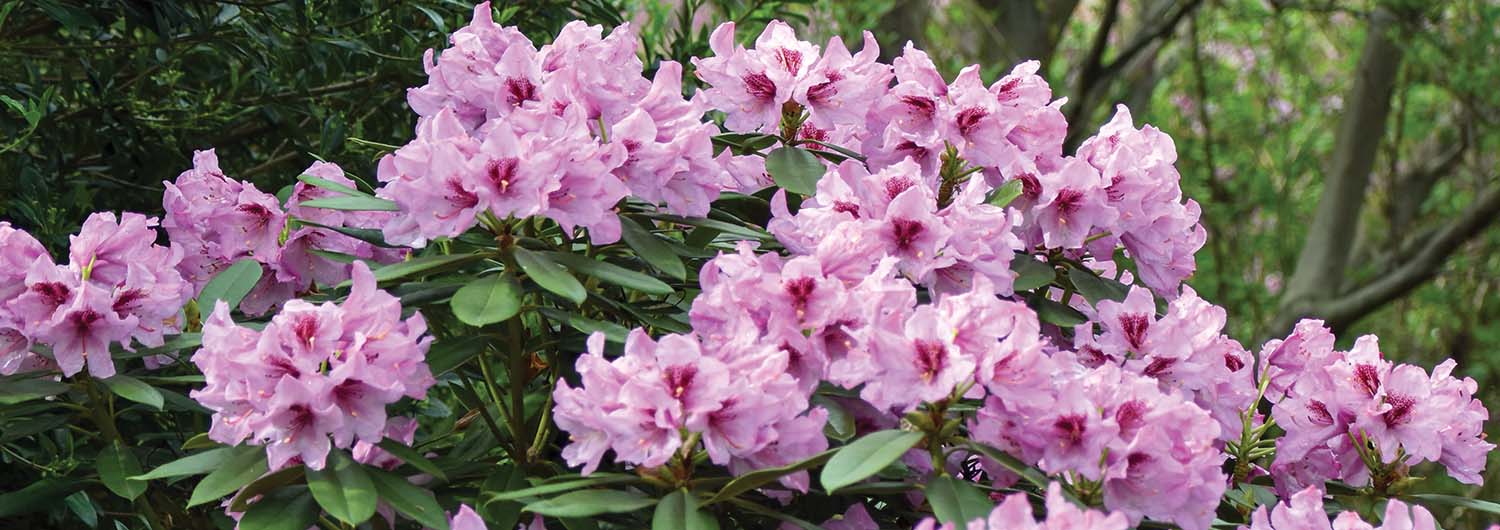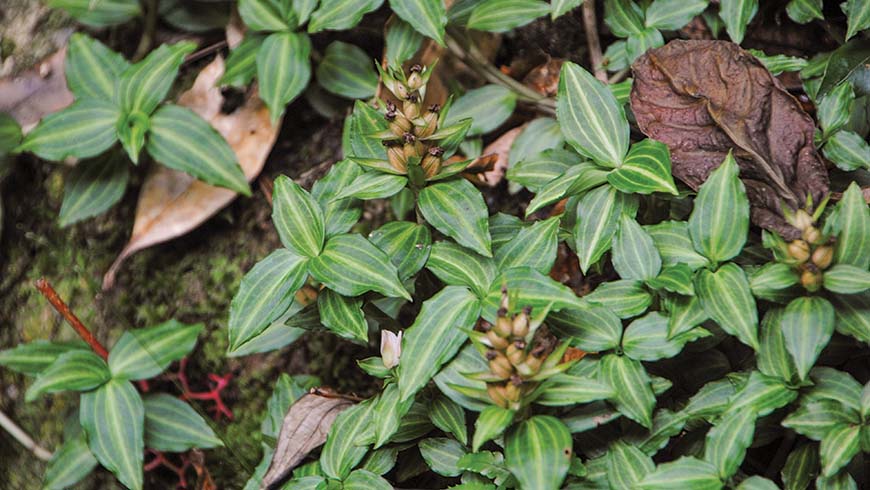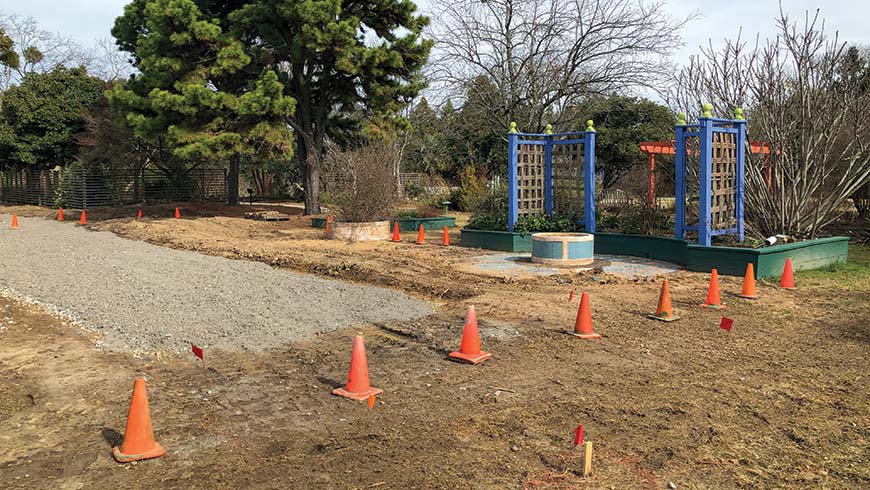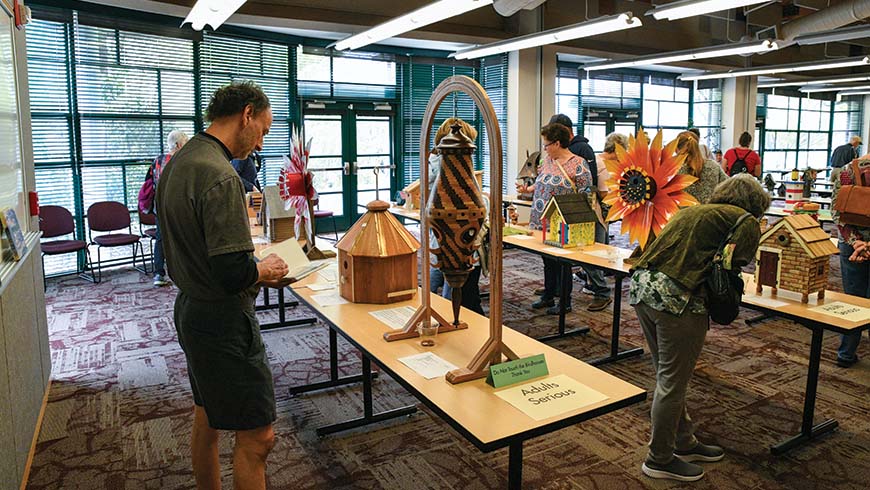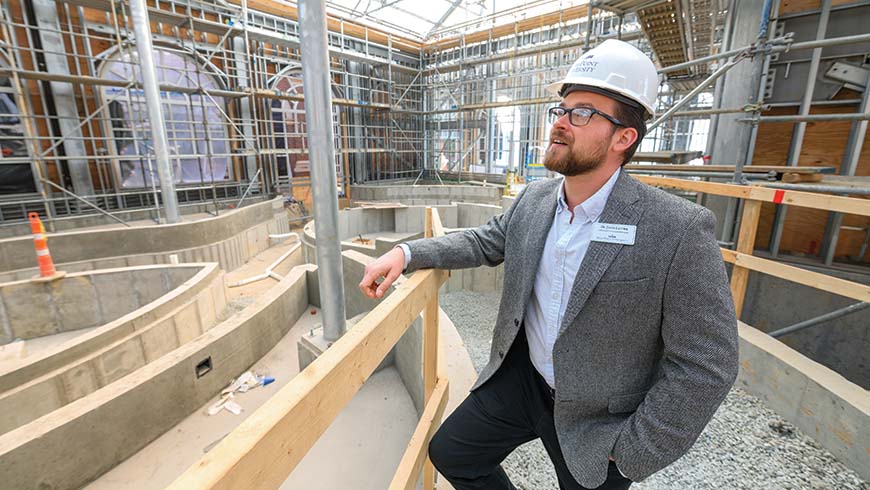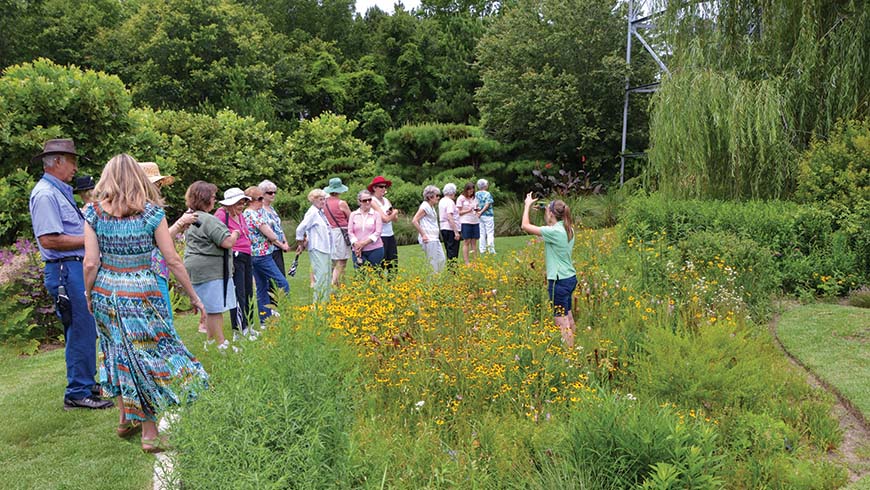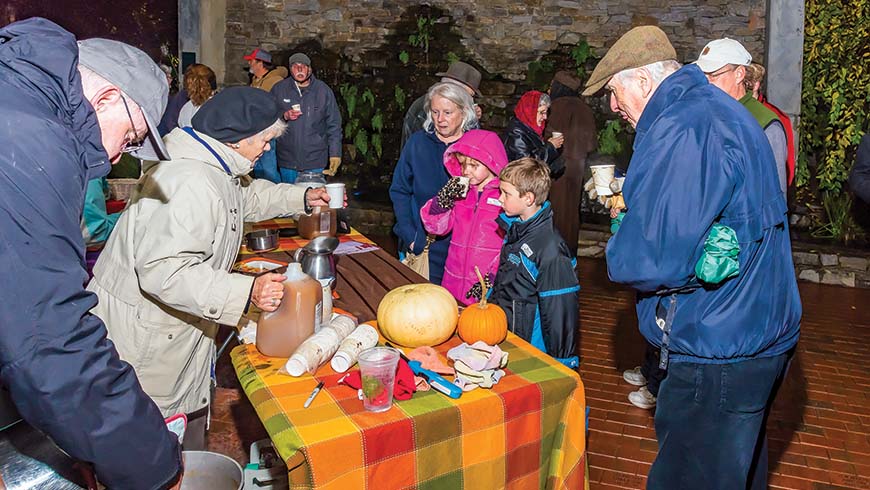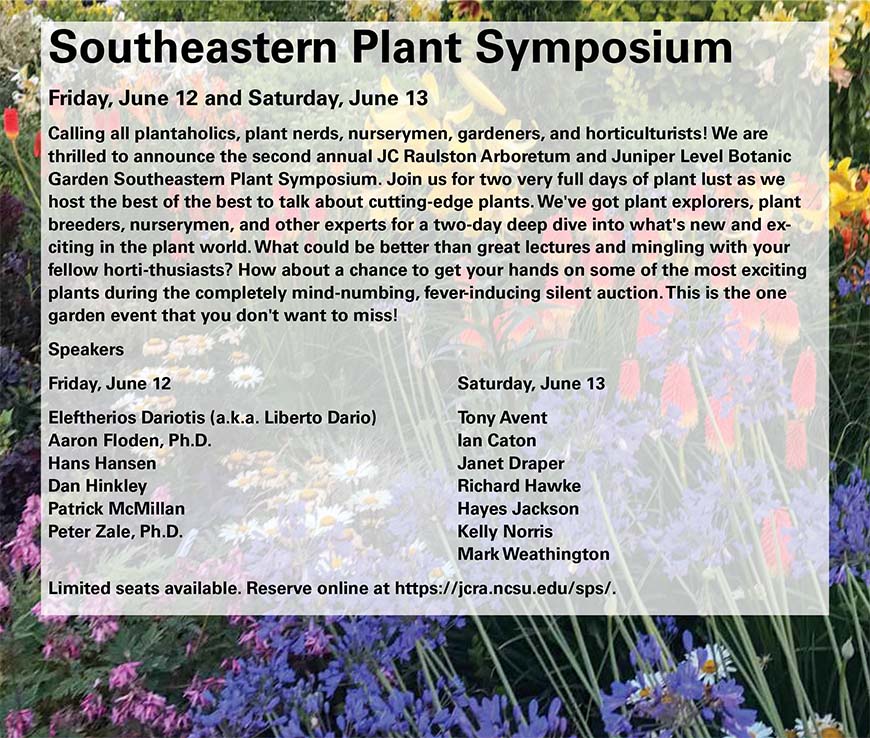Friends of the JC Raulston Arboretum Newsletter
Spring 2020 – Vol. 23, No. 1
Director's Letter
Greetings from the JC Raulston Arboretum
By Mark Weathington, Director
Sustainability has become quite the buzzword over the last decade, but I've yet to find someone who could adequately define what that really means. In terms of gardens, I have come to prefer the term resiliency. A resilient garden can take what comes and survive, perhaps even adapt and thrive under the new conditions. Gardens can be resilient in many ways, they can be full of plants which flourish under very different conditions or they can be constructed in such a way that their soils mitigate drastic changes, to provide just a couple of examples.
The JC Raulston Arboretum strives to be resilient from its plantings to its operations. In many cases, we are just fine with plants struggling so we can evaluate their true performance. Part of our resiliency is that there are so many plants out there just waiting in the wings for a chance to prove themselves in the garden that the inevitable losses provide valuable information. The design and layout of the JCRA also changes over time to make for a more robust space. As our visitation increases year by year, we find areas which need to be updated to thrive under these new conditions. Along with the grounds, our programming strives to be adaptable, changing with the evolving needs and nature of our audiences. Read ahead in the newsletter to learn about some of the changes to the Arboretum designed to keep us resilient.
Resiliency is more than plants, paths, and programs, though. To ensure the JCRA is positioned for the next phase of its existence, we work to make sure our finances are prepared for a changing world. In its infancy, the Arboretum and its staff were funded largely through the University. As recently as five years ago, the university supported salaries and some operational funding. Today, there is little university support, but we have adapted to keep our operations resilient by growing memberships, increasing year-end gifts and annual support, developing new garden-based programming and events, improving rental spaces and experiences, and building our endowment.
All of our financial stability and growth has been thanks to you, our members. You support our programs, you encourage friends and neighbors to visit and become members themselves, you give to our annual appeals and participate in our events. Thanks to you, we are a strong, vibrant, buoyant institution with a dedicated staff and volunteer workforce determined to help make our Arboretum and our world a more resilient place.
Horticulture
New Additions from 2019
By Mark Weathington, Director
I heard such a positive response to last year's inclusion of an abbreviated list of accessions from the past year, I've decided to do so again in homage to the old school newsletters from our first years. Here is a small sampling of the 1,533 accessions from 2019.
Adinandra millettii (ABGG red/purple clone)
Abies beshanzuensis – A critically endangered species from Zhejiang province in China which is closely allied to Abies firma and which should prove to be an excellent plant for us.
Acer tonkinense
Angiopteris sp. (MWZ19-025)
Ardisia primulifolia (MWZ19-016)
Aristea anceps
Aucuba albopunctifolia (MWZ18-066)
Betula ovalifolia
Briggsia chienii (MWZ19-074) – One of several hardy gesneriads (African violet relatives) we collected in the mountains of southern China.
Cercis canadensis 'Mini Hearts'
Cercis chuniana
Chlorophytum orchidastrum
Cornus elliptica 'Ncce1' (Lucky Leprechaun)
Erodium manescavi
Galanthus bursanus 'Isla Louise'
Galanthus 'Chatwood'
Galanthus 'Dionysus'
Galanthus fosteri
Galanthus koenenianus
Galanthus krasnovii
Galanthus platyphyllus
Galanthus samothracicus
Galanthus trojanus
Goodyera henryi (MWZ19-0643) – An amazing, hardy, small-scale spreading woodland ground cover from southern China with showy foliage and flowers.
Gutierrezia sarothrae
Ilex championii (MWZ19-024)
Ilex ficoidea (MWZ19-067)
Ilex rotunda (yellow fruit) (MWZ19-064)
Ilex triflora (MWZ19-046) – Our 2019 south China collecting trip exposed me to several species of non-spiny leaved hollies which may have real potential for the landscape industry.
Iris grant-duffii
Lycoris 'Mountain Rose'
Magnolia globosa 'Pink Petticoats'
Magnolia insignis 'Valerius Red'
Magnolia lotungensis 'Cherry Lips'
Magnolia maudiae 'Lucky'
Magnolia aff. obovalifolia
Musella lasiocarpa var. rubribracteata – The orange-red flowered form of hardy dwarf banana.
Phoebe formosana
Pinckneya pubens 'Precocious'
Polygonatum aff. martini (MWZ19-014)
Pseudotaxus chienii
Rhododendron championiae (MWZ19-007)
Rohdea pachynema (MWZ18-066)
Stewartia koreana 'Lindstrom's Weeping'
Stewartia sinensis var. brevicalyx (MWC16-1149)
Ternstroemia kwangtungensis (MWZ19-059)
Tripterospermum chinense (MWZ19-060)
Vernicia fordii 'Auntie Freeze'
Yucca aloifolia 'Magenta Magic'
Zingiber nanlingensis (HJM15008)
The JCRA Perennial Border History—The Early Years
By Douglas Ruhren, Gardens Manager, and Edith Eddleman, Volunteer
The Perennial Border has been a major part of the JC Raulston Arboretum at NC State University for 38 years. It's best to write a history while the primary sources still remember the details of that history.
Its history began with a master plan designed by Fielding Scarborough for his Master's thesis in the NC State's College of Design for the Arboretum. It included a perennial border in its current location.
In 1982, J. C. Raulston requested that horticulture professor Tracy Traer's students in her HS 416 class design several features for the Arboretum: a perennial border, a winter garden, and a Japanese garden from Fielding's master plan. A perennial border was an amazing leap of faith for J. C. because he strongly favored woody plants over herbaceous ones. As proof of his reluctance to include a perennial border, know that it was decades after record keeping began at the Arboretum that it became routine to keep records on herbaceous perennials as well.
Edith Eddleman and Valinda Sames were the students in this class who selected the design of a perennial border as their project. The two students met with J. C., and instead of showing the south-facing location that the border currently occupies, he showed them the opposite side, the north-facing side that is now the Mixed Border. At this point, Edith failed to convince J. C. to move it to its current location. A horticulture class had recently moved a collection of roses to this south facing bed, and J. C. was quite convinced that having a class move the roses again would be risky to his own health.
For the record, it should be noted that the 'Nellie R. Stevens' holly hedge predated the planting of the Mixed Border and the Perennial Border. The hollies were planted in 1978 as one-gallon plants, 4' apart, along what was then the entire southern boundary of the Arboretum as well as behind the Perennial Border. In 1982, the hollies weren't quite yet 40' tall and 30' wide. That would take a few more days.
It was Edith's design that was chosen. Edith's inspiration was a border designed by the mother of the modern perennial border, Gertrude Jekyll (1843–1932). The design appears in her 1908 classic, Colour Schemes for the Flower Garden. It is a color study. In Edith's own words: "I attempted to follow Jekyll's color study, moving from gray foliage plants combined with pastel pink, yellow, and lavender flowered plants into deep intense red, yellow, orange, and purple flowered plants; then returning to the pastels but with blue flowers replacing the lavender ones." Edith's design, of course, was designed with a very different palette of plants, ones adapted to the local growing conditions.
A month later J. C. changed his mind as to the Perennial Border's location. It would go, after all, in its current location. So, Edith whipped up a new plan for the larger space, then 250' long by 18' deep. Edith submitted the plan to J. C. along with a list of plants to be purchased. At that time, Edith was working on weekends and could not attend the weekend execution of her plan in March of 1983. Edith's visit the following Monday revealed that her plan had indeed been executed. In Edith's words: "I rounded the corner and was greeted by what appeared to be a mouse graveyard, with hundreds of plant markers, and huge 15-foot sweeps of Easter lilies (Lilium longiflorum) in full bloom. The Easter lilies were the legacy of Dr. August DeHertog's bulb research program, commandeered for the border by Dr. Raulston. In addition to the lily sweeps, many other plants had appeared that were not part of the original design. Every 15 feet were huge clumps of bronze-leaved hybrid cannas followed by swamp sunflower (Helianthus angustifolius), fronted by the Easter lilies, then the piéce de resistance—clumps of variegated hostas arrayed in threes every 20 feet or so. Gone with the weekend was my carefully envisaged color scheme."
Two and a half months later, Edith ran into J. C. at the North Carolina Botanical Garden in Chapel Hill where J. C. was lecturing. J. C. suggested to Edith that the border needed a caretaker and Edith was hired for a salary of twelve dollars and fifty cents (yes, $12.50) for eight hours of work every other week. Edith muddled through the rest of that summer, growing ever more convinced that the only solution was yet again a total redo. Sufficiently emboldened, Edith approached J. C. who agreed to a new start. It will never be known if J. C.'s agreement had anything to do with the fact that he was on top of a step ladder at that moment.
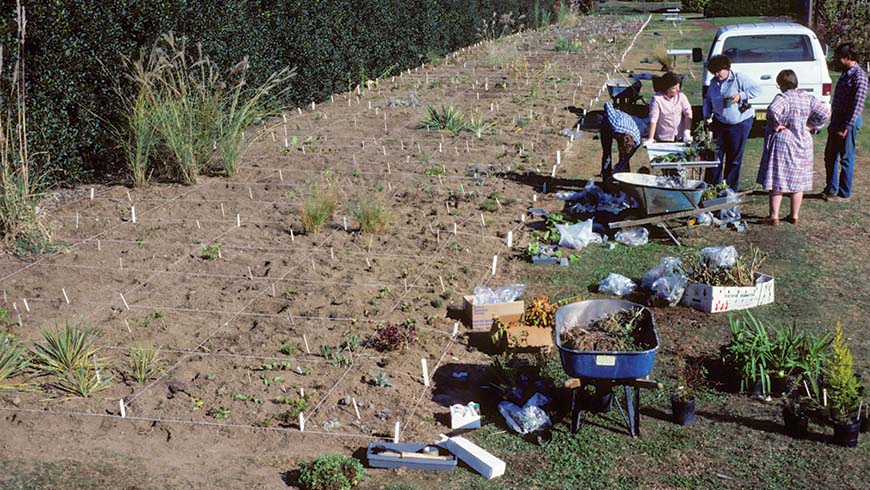
Edith redrew the plan at the very generous scale of 1" equals 1' so the plan would be easier for others to interpret. A workday was held on which all plants were dug, labeled, and bagged and placed into cold storage until the site could be prepared and replanted, which occurred a month later, in November. This time, Edith laid out all the plants, guaranteeing that her design was properly interpreted. So, finally all was right in the Perennial Border.
Except that the fall of 1983 was unusually mild. That, and the plants having spent a month in the cold storage thought that they had already gone through winter so came into tender new growth as if it were spring. Had winter behaved, as it never does, and came on gradually, the resulting tragedy might not have occurred. But Christmas Eve of 1983 started out at 70°F and dropped to 5°F in four hours. Needless to say, the Perennial Border was almost totally devoid of plants come spring of 1984.
My goodness! With the space limitations of this newsletter, we have only gotten through the first two years, the two most tumultuous years I might add, of the JCRA Perennial Border. And this with leaving out countless other details, such as the 3,000 pink petunias. I hope that enough of you have found this to be worthwhile. We hope to record a more complete history in the near future while Edith Eddleman and I still remember the details. Perhaps we will even do an illuminated lecture on the topic for the Friends of the Arboretum. To be continued.…
Arboretum Updates
The Roaring Twenties
By Mark Weathington, Director
The Twenties are going to be roaring at the Arboretum as we look to kick off the decade with some fantastic garden projects and changes. Already in the works is a new pathway around the Great Lawn funded in part by the NC Science Museum's Grant Program which will make the entire JCRA more accessible for visitors as well as maintenance and vehicles. The master plan design committee didn't waste any time in January before they were out and staking the new "road's" outline. The new pathway will also provide opportunities for new garden spaces and an expanded Mixed Border. Soil excavated for this project will be used to build beds and berms in other garden spots. Helping to make a better, more stately transition from the Great Lawn and Perennial Border to the White Garden will be a new arbor funded by the Lundy Fetterman Foundation.
We're also planning a major renovation of one of the most iconic student projects in the garden—The Necessary; thanks to a generous gift from Carol and Rick McNeel. Their naming level gift provides the means to perform needed repairs as well as updates to the interior and surrounding gardens, including improving its accessibility. Other projects for 2020 include installation of a vine support system on the Ruby C. McSwain Education Center and steps leading up from the Sunken Garden along the north side of the McSwain Center to the main entry path. It is certainly going to be a busy year!
As the Arboretum grows, like any garden, it changes and evolves. Some beloved plants and trees will certainly be removed as we move forward, but our mission to inspire a passion for plants and to diversify the American landscape remains the same. Just as the physical garden changes over time, so too do our programs and events. With the 2019 success of our new mission-centric Southeastern Plant Symposium, in conjunction with Juniper Level Botanic Garden, the staff and board have taken a long hard look at our other programs to see if it is time for some of them to be updated, replaced, or retired.
As programming has increased across the board, it became obvious that one of the JCRA's longest running programs, Gala in the Garden, had sadly reached the end of its life cycle. We will all miss the fantastic fun we had every year with so many long-standing friends, but look forward to future events which will bring plants and horticulture alive for even more people. Thankfully J. C.'s legacy of change and evolution of the Arboretum helps us look forward with confidence at the exciting changes and opportunities ahead. For those of you who are distressed over losing the rare plant auction, do not worry! An even more epic plant auction happens at the Southeastern Plant Symposium and while we would love for you to join us for the event, mobile bidding is also open to attendees and non-attendees alike. Last year's auction brought exceptional plants from the most sought out collections. I can't wait to see what this year brings.
A garden is never finished, but is rather an evolving series of moments in time. We're looking forward to sharing our evolution with all of you as we create new opportunities for immersive and meaningful horticultural experiences in the decade ahead.
With Spring Comes the Birds …
By Sana Sheikh, Programs and Education Assistant
… and our 20th Annual Birdhouse and Beyond Competition! Welcome the new season with fellow artists and art enthusiasts alike with the 20th anniversary of our classic seasonal celebration.
This year, the JCRA's new Air Bee and Bee bee hotel inspired us to expand the competition to include all kinds of animal habitats—not just birds. We're here to raise awareness about all helpful critters in our garden! Birds aren't the only ones that help our gardens grow or use them to take refuge. Whether you've built homes for bats, butterflies, or hedgehogs, decorated the perfect abodes for your toads, or have bee hotels ready for check-in, this is the perfect opportunity to flaunt your creative side and put them on display.
The Birdhouse Competition was the first multi-day event hosted by the JC Raulston Arboretum and the most highly attended event for a number of years. While always held in mid-March, the staff decided to move the event to April to coincide with the first-ever plant sale.
Beth Jimenez, a primary figure in the creation of the Birdhouse Competition and a judge for the competition, told us a little bit more about the event. While the idea for the competition was originally coined by her friend Beth Wiegand, a food writer for the News and Observer at the time, Beth Jimenez reached out to the Arboretum to make it happen. Since then, the Birdhouse Competition has stuck around for 20 years, with competitors frequently returning to show off their houses.
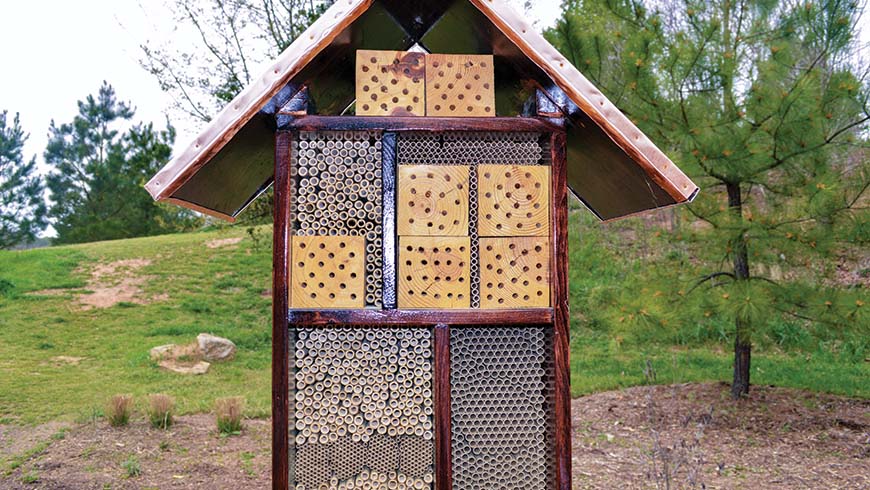
For Beth, the most rewarding part of the competition is getting to see all of the clever designs and finished pieces that artists bring to the competition. While it may be difficult for her to pick only three to take the awards home in each category, she said she has enjoyed rewarding the skill and work that went into the winning houses.
Beth believes that the expanded competition is "going to make judging even more exciting and open up a renewed awareness of taking care of all our garden 'helpers'."
Adult competitors are able to enter in either the Serious category for more functional creations or the Flight of Fancy category for decorative entries. As always, youth competitors (ages 4 to 16) will be put into four categories based on their age.
Anyone is invited to join! We accept both groups and individual contestants, and any contestant can enter multiple entries.
The cost to enter is free, and builders will receive a free ticket to attend Raulston Blooms! So what are you waiting for? Register today at https://jcra.ncsu.edu/birdhouses-and-beyond/.
Where Are They Now—The Future of the Arboretum's Past Interns
By Sana Sheikh, Programs and Education Assistant
The JC Raulston Arboretum's Internship Program has evolved with the Arboretum since the days of J. C. Raulston himself during the 80s and 90s. The program has mutually helped the Arboretum while jump starting the futures of a number of unique and deserving students. So where are those interns now? We got in touch with a few to find out.
Rachel Buress
Rachel joined the Arboretum as an intern in the summer of 2015, drawn in by the Arboretum's unique array of plants and her own interest in ornamental plants. During her time here, the interns operated heavy machinery and did physical work in the garden, including mulching, which Rachel said she loves to do now. One of her most distinct memories was of getting into accidents; Rachel was so accident-prone that the group kept a calendar tracking how many days she could go without getting hurt. Now a greenhouse manager at a research station in Mills River, Rachel's time at the Arboretum helped her make lifelong friends that she keeps in contact with to this day.
Kamen Dedmon
During the summer that Kamen interned with the Arboretum, his group worked on a variety of garden projects including the construction of the Arboretum's yurt, and working with volunteers. While the Arboretum wasn't Kamen's first choice at an internship, he said that it was the best thing that could have ever happened to him and provided him with networking opportunities among the influential individuals who frequented the Arboretum. Working on the yurt was Kamen's first construction project, and while he initially felt out of his element, being able to connect with the other interns and feel like a part of the team helped him grow comfortable with the construction work and even get excited about it. Kamen is now a grower at Hoffman Nursery and is responsible for 12 poly greenhouses.
Justin Durango
Justin decided to intern with the Arboretum in the summer of 2012 after he realized his passion for horticulture and came back to NC State to study it. He had already done volunteer work with the Arboretum and fell in love with it through his visits, so deciding to intern here was a no-brainer! The internship group that Justin was in got along so well that they would sing to each other as they worked in the garden, and Justin found himself acting as their foreman. Justin has a real passion for landscaping work and currently runs a landscaping company called Garden Harmony.
Jason Lattier
After graduating with his undergraduate degree in horticulture, Jason (photograph above) was looking to do some internships before he went to graduate school. Learning about the legacy of J. C. Raulston at NC State and the Arboretum's rare plant collection triggered Jason's interest in working with that collection himself. While there, Jason's group helped install the Geophyte Border and part of the Scree Garden. Jason said that working in the Scree Garden in the middle of summer was seared into his mind. The Arboretum was under watering restrictions, which meant that they had to figure out how to maintain the gardens under the imposed limit. Despite it being a tough summer, everyone worked without complaint. Working with others who were so passionate about plants made him realize that the work was exactly what he wanted to do with his life. Jason recently finished his post-doc and is the director of the Caine Conservatory at High Point University where he is overseeing its establishment.
Elisabeth Meyer
Elisabeth interned at the Arboretum the summer of 2005. On top of regular plant maintenance, Elisabeth's group did an entire redo of the then-installed sculpture garden. Elisabeth had always really loved the Arboretum and admired its reputation. One of Elisabeth's favorite memories from her time with the Arboretum was going on a fully paid trip to Longwood Garden, a botanical garden she always wanted to visit. Working at the Arboretum cemented her understanding of plant species and deepened her horticultural knowledge. Elisabeth now works as a senior lecturer at NC State's Department of Horticultural Science.
Stephen Panasci
After hearing rave reviews about the Arboretum, Stephen decided to work as a summer intern at the Arboretum in 2008. The Arboretum's new master plan had just been completed, so Stephen was involved in landscape design and implementing significant improvements to areas of the Arboretum, including sculpting the hillside of the Asian Valley and removing plants from the Lath House. There was always something new and exciting going on, which Stephen loved. Stephen got his Master's degree in landscape architecture at Temple University. Missing the amount of hands-on horticultural work in his life, Stephen started a new business in 2019 involving landscape design, small organic and urban farms, and food production.
Danielle Smith
Danielle was the education intern for the Arboretum during the summer of 2015. Since then, she has worked with various JCRA camps or projects each summer. Danielle was intrigued by the idea of outdoor education and was certain it would be an amazing opportunity. One of her most memorable experiences was teaching a camp called Garden Chefs and searching for recipes for the kids to do, something she said that she may have been more excited about than the kids. They made a great pesto with basil right from the garden. As a first grade teacher in Wake County, she uses her experiences from teaching outdoor science lessons at the Arboretum in her classroom. Danielle has started a Green Team club at her school, is the co-chair of their gardens and grounds committee, and teaches her students how to grow their own vegetables in their garden.
Rebecca Turk
Rebecca (photograph above, on right) did her internship during the summer of 2010 as the first JCRA graduate student working full-time at the Arboretum. The most memorable part of working at the Arboretum for Rebecca was the staff's knowledge. Being able to have so many mentors that pushed her boundaries helped Rebecca get where she is today. Her experience at the Arboretum helps her with her work as the director of education and events at Moore Farms Botanical Garden, where she runs the entire visitation program.
As evidenced through these stories, internships offer invaluable experiences. Interns not only have the opportunity to gain hands-on skills, but also to create lasting connections that will aid them in both their personal and professional lives. Please consider supporting the JCRA Internship Program to ensure that we can continue offering important and memorable opportunities to students.
Volunteering
Volunteer Couples at the JCRA
By Sana Sheikh, Programs and Education Assistant
The couple that gardens together stays together. Here at the Arboretum, we have plenty of wonderful couples among our decorated list of volunteers who garden and volunteer together. Get to know the couples that help the Arboretum stay on its feet!
Anna and Meredith Berry
Anna and Meredith are both avid gardeners. While Anna started at the Arboretum first, Meredith wanted to join his wife and volunteer together. Volunteering at the Arboretum is something that this couple does as a team! While Meredith works primarily on special events like the Annual Plant Distribution and Moonlight in the Garden, Anna is on the volunteer event planning committee as well.
Amelia and Richard Lane
Amelia started volunteering in 1990 when she and her husband Richard first moved to Raleigh. Since Richard semi-retired, he has volunteered for about 10 years. While they don't volunteer together or work on the same days, the Arboretum often comes up for the couple as a topic of conversation. Amelia works in the Mixed Border, the ephemeral art committee, special events, and is on the Arboretum's Board of Advisors. Richard works with the construction crew and on other special projects.
Vanette and Thearon McKinney
Vanette and Thearon (photograph above, on left) chose to join the JCRA together around 2007 while searching for a venue for their daughter's wedding. The friendly people and array of volunteer opportunities made the Arboretum a great choice. The couple works together in the Japanese Garden, including regular cleaning and planting. They also act as regular volunteers for Moonlight in the Garden. Volunteering helps them build friendships and appreciate the interests and skills that the other holds. This pair is a team in their own garden, too; while Thearon focuses on the big picture, Vanette loves to work on the details and is an excellent weeder.
Trish and Kerry MacPherson
Trish was the first to volunteer in about 2009. Kerry joined her in 2013 after he had retired. Trish learned about as much from the Master Gardener program as she did from Tim Alderton, research technician, and has done gardening on Tuesdays for nine years, including working on the entrance garden. Kerry works with the construction team on Thursdays to build, fix, and paint. While they volunteer on different days, the pair often goes to lectures, tours, and other events together. Trish and Kerry have their own garden at home on six acres of land that they've kept for 20 years.
Faye and Gale Koonce
Faye retired from the JCRA after over 40 years of working at NC State University and Gale grew acquainted with the JCRA staff, making volunteering at the Arboretum a great choice. You'll find Faye at the front desk and Gale processes membership packets and volunteer hours and is part of our engraving team. The couple also supports special events. Of these two, Faye is the plant nut, and keeps plants scattered throughout the yard.
The Arboretum is a great place to make memories with your loved one and be a part of an amazing community. Join us and become a part of the volunteer program together! You're guaranteed to have a great time. Please contact Kathryn Wall at (919) 513-7004 or kbwall@ncsu.edu for more information.
Annual Report
2019 JC Raulston Arboretum Annual Report
There are many people to thank for their support in 2019. In an effort to conserve resources, the full 2019 annual report is offered on the JCRA Web site at https://jcra.ncsu.edu/publications/annual-reports/ instead of printed copies. A few highlights of our record-setting year (all-time membership count, Moonlight in the Garden selling out, etc.) are included below.

